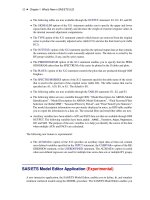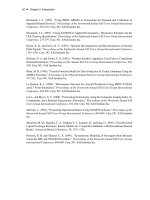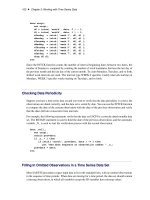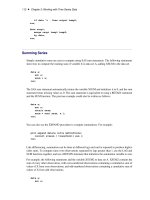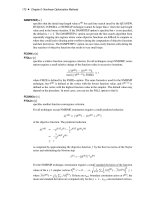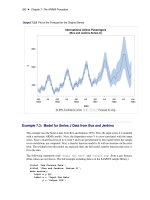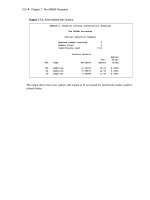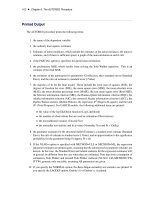SAS/ETS 9.22 User''''s Guide 3 ppt
Bạn đang xem bản rút gọn của tài liệu. Xem và tải ngay bản đầy đủ của tài liệu tại đây (216.74 KB, 10 trang )
12 ✦ Chapter 1: What’s New in SAS/ETS 9.22
The following tables are now available through the OUTPUT statement: E1, E2, E3, and E8.
The SIGMALIM option of the X11 statement enables you to specify the upper and lower
sigma limits that are used to identify and decrease the weight of extreme irregular values in
the internal seasonal adjustment computations.
The TYPE option of the X11 statement controls which factors are removed from the original
series to produce the seasonally adjusted series (table D11) and also the final trend cycle (table
D12).
The OUTSTAT= option of the X12 statement specifies the optional output data set that contains
the summary statistics related to each seasonally adjusted series. The data set is sorted by the
BY-group variables, if any, and by series names.
The PERIODOGRAM option of the X12 statement enables you to specify that the PERI-
ODOGRAM rather than the SPECTRUM of the series be plotted in the G tables and plots.
The PLOTS= option of the X12 statement controls the plots that are produced through ODS
Graphics.
The SPECTRUMSERIES option of the X12 statement specifies the table name of the series
that is used in the spectrum of the original series (table G0). The table names that can be
specified are A1, A19, B1, or E1. The default is B1.
The following tables are now available through the TABLES statement: E1, E2, and E3.
The following tables are now available through ODS: “Model Description for ARIMA Model
Identification”, “Model Description for ARIMA Model Estimation”, “Final Seasonal Filter
Selection via Global MSR”, “Seasonal Filters by Period”, and “Final Trend Cycle Statistics”.
The model description information was previously displayed in notes; an ODS table enables
you to export the information to a data set. The seasonal filter and trend filter tables are new.
Auxiliary variables have been added to ACF and PACF data sets that are available through ODS
OUTPUT. The following variables have been added: _NAME_, Transform, Adjust, Regressors,
Diff, and Sdiff. The purpose of the new variables is to help you identify the source of the data
when multiple ACFs and PACFs are calculated.
The following new feature is experimental:
The AUXDATA= option of the X12 specifies an auxiliary input data set that can contain
user-defined variables specified in the INPUT statement, the USERVAR= option of the RE-
GRESSION statment, or the USERDEFINED statement. The AUXDATA= option is useful
when user-defined regressors are used for multiple time series data sets or multiple BY groups.
SAS/ETS Model Editor Application (Experimental)
A new interactive application, the SAS/ETS Model Editor, enables you to define, fit, and simulate
nonlinear statistical models using the MODEL procedure. The SAS/ETS Model Editor enables you
Date Intervals, Formats, and Functions ✦ 13
to use the powerful features of PROC MODEL through a convenient and interactive graphical user
interface.
Date Intervals, Formats, and Functions
The custom time intervals that are available in Base SAS software can be used in SAS/ETS procedures.
Custom time intervals enable you to specify beginning and ending dates and seasonality for time
intervals according to any definition. Such intervals can be used to define the following:
fiscal intervals such as monthly intervals that begin on a day other than the first day of the
month (for example, intervals that begin on the 10th day of each month)
fiscal intervals such as monthly intervals that begin on different days for different months (for
example, March of 2000 can begin on March 10, but April of 2000 can begin on April 12)
business days, such as banking days that exclude holidays
hourly intervals that omit hours that the business is closed
14
Chapter 2
Introduction
Contents
Overview of SAS/ETS Software . . . . . . . . . . . . . . . . . . . . . . . . . . . 16
Uses of SAS/ETS Software . . . . . . . . . . . . . . . . . . . . . . . . . . . 17
Contents of SAS/ETS Software . . . . . . . . . . . . . . . . . . . . . . . . 18
About This Book . . . . . . . . . . . . . . . . . . . . . . . . . . . . . . . . . . . 20
Chapter Organization . . . . . . . . . . . . . . . . . . . . . . . . . . . . . 20
Typographical Conventions . . . . . . . . . . . . . . . . . . . . . . . . . . . 21
Where to Turn for More Information . . . . . . . . . . . . . . . . . . . . . . . . . 22
Accessing the SAS/ETS Sample Library . . . . . . . . . . . . . . . . . . . 22
Online Help System . . . . . . . . . . . . . . . . . . . . . . . . . . . . . . 22
SAS Short Courses . . . . . . . . . . . . . . . . . . . . . . . . . . . . . . . 23
SAS Technical Support Services . . . . . . . . . . . . . . . . . . . . . . . . 23
Major Features of SAS/ETS Software . . . . . . . . . . . . . . . . . . . . . . . . 23
Discrete Choice and Qualitative and Limited Dependent Variable Analysis . 23
Regression with Autocorrelated and Heteroscedastic Errors . . . . . . . . . 25
Simultaneous Systems Linear Regression . . . . . . . . . . . . . . . . . . . 26
Linear Systems Simulation . . . . . . . . . . . . . . . . . . . . . . . . . . . 28
Polynomial Distributed Lag Regression . . . . . . . . . . . . . . . . . . . . 28
Nonlinear Systems Regression and Simulation . . . . . . . . . . . . . . . . 29
ARIMA (Box-Jenkins) and ARIMAX (Box-Tiao) Modeling and Forecasting . 31
Vector Time Series Analysis . . . . . . . . . . . . . . . . . . . . . . . . . . 32
State Space Modeling and Forecasting . . . . . . . . . . . . . . . . . . . . 34
Spectral Analysis . . . . . . . . . . . . . . . . . . . . . . . . . . . . . . . . 34
Seasonal Adjustment . . . . . . . . . . . . . . . . . . . . . . . . . . . . . . 35
Structural Time Series Modeling and Forecasting . . . . . . . . . . . . . . . 36
Time Series Cross-Sectional Regression Analysis . . . . . . . . . . . . . . . . 37
Automatic Time Series Forecasting . . . . . . . . . . . . . . . . . . . . . . 38
Time Series Interpolation and Frequency Conversion . . . . . . . . . . . . . 39
Trend and Seasonal Analysis on Transaction Databases . . . . . . . . . . . . 41
Access to Financial and Economic Databases . . . . . . . . . . . . . . . . . 42
Spreadsheet Calculations and Financial Report Generation . . . . . . . . . . 44
Loan Analysis, Comparison, and Amortization . . . . . . . . . . . . . . . . 45
Time Series Forecasting System . . . . . . . . . . . . . . . . . . . . . . . . 46
Investment Analysis System . . . . . . . . . . . . . . . . . . . . . . . . . . . 47
ODS Graphics . . . . . . . . . . . . . . . . . . . . . . . . . . . . . . . . . 48
16 ✦ Chapter 2: Introduction
Related SAS Software . . . . . . . . . . . . . . . . . . . . . . . . . . . . . . . . 48
Base SAS Software . . . . . . . . . . . . . . . . . . . . . . . . . . . . . . 49
SAS Forecast Studio . . . . . . . . . . . . . . . . . . . . . . . . . . . . . . . 51
SAS High-Performance Forecasting . . . . . . . . . . . . . . . . . . . . . . 52
SAS/GRAPH Software . . . . . . . . . . . . . . . . . . . . . . . . . . . . 52
SAS/STAT Software . . . . . . . . . . . . . . . . . . . . . . . . . . . . . . 53
SAS/IML Software . . . . . . . . . . . . . . . . . . . . . . . . . . . . . . . 54
SAS/IML Stat Studio . . . . . . . . . . . . . . . . . . . . . . . . . . . . . 55
SAS/OR Software . . . . . . . . . . . . . . . . . . . . . . . . . . . . . . . 55
SAS/QC Software . . . . . . . . . . . . . . . . . . . . . . . . . . . . . . . 56
MLE for User-Defined Likelihood Functions . . . . . . . . . . . . . . . . . 56
JMP Software . . . . . . . . . . . . . . . . . . . . . . . . . . . . . . . . . . 57
SAS Enterprise Guide . . . . . . . . . . . . . . . . . . . . . . . . . . . . . 58
SAS Add-In for Microsoft Office . . . . . . . . . . . . . . . . . . . . . . . 59
Enterprise Miner—Time Series nodes . . . . . . . . . . . . . . . . . . . . . 59
SAS Risk Products . . . . . . . . . . . . . . . . . . . . . . . . . . . . . . . 60
References . . . . . . . . . . . . . . . . . . . . . . . . . . . . . . . . . . . . . . . 61
Overview of SAS/ETS Software
SAS/ETS software, a component of the SAS System, provides SAS procedures for:
econometric analysis
time series analysis
time series forecasting
systems modeling and simulation
discrete choice analysis
analysis of qualitative and limited dependent variable models
seasonal adjustment of time series data
financial analysis and reporting
access to economic and financial databases
time series data management
In addition to SAS procedures, SAS/ETS software also includes seamless access to economic and
financial databases and interactive environments for time series forecasting and investment analysis.
Uses of SAS/ETS Software ✦ 17
Uses of SAS/ETS Software
SAS/ETS software provides tools for a wide variety of applications in business, government, and
academia. Major uses of SAS/ETS procedures are economic analysis, forecasting, economic and
financial modeling, time series analysis, financial reporting, and manipulation of time series data.
The common theme relating the many applications of the software is time series data: SAS/ETS
software is useful whenever it is necessary to analyze or predict processes that take place over time
or to analyze models that involve simultaneous relationships.
Although SAS/ETS software is most closely associated with business, finance and economics, time
series data also arise in many other fields. SAS/ETS software is useful whenever time dependencies,
simultaneous relationships, or dynamic processes complicate data analysis. For example, an environ-
mental quality study might use SAS/ETS software’s time series analysis tools to analyze pollution
emissions data. A pharmacokinetic study might use SAS/ETS software’s features for nonlinear
systems to model the dynamics of drug metabolism in different tissues.
The diversity of problems for which econometrics and time series analysis tools are needed is
reflected in the applications reported by SAS users. The following listed items are some applications
of SAS/ETS software presented by SAS users at past annual conferences of the SAS Users Group
International (SUGI).
forecasting college enrollment (Calise and Earley 1997)
fitting a pharmacokinetic model (Morelock et al. 1995)
testing interaction effect in reducing sudden infant death syndrome (Fleming, Gibson, and
Fleming 1996)
forecasting operational indices to measure productivity changes (McCarty 1994)
spectral decomposition and reconstruction of nuclear plant signals (Hoyer and Gross 1993)
estimating parameters for the constant-elasticity-of-substitution translog model (Hisnanick
1993)
applying econometric analysis for mass appraisal of real property (Amal and Weselowski
1993)
forecasting telephone usage data (Fishetti, Heathcote, and Perry 1993)
forecasting demand and utilization of inpatient hospital services (Hisnanick 1992)
using conditional demand estimation to determine electricity demand (Keshani and Taylor
1992)
estimating tree biomass for measurement of forestry yields (Parresol and Thomas 1991)
evaluating the theory of input separability in the production function of U.S. manufacturing
(Hisnanick 1991)
18 ✦ Chapter 2: Introduction
forecasting dairy milk yields and composition (Benseman 1990)
predicting the gloss of coated aluminum products subject to weathering (Khan 1990)
learning curve analysis for predicting manufacturing costs of aircraft (Le Bouton 1989)
analyzing Dow Jones stock index trends (Early, Sweeney, and Zekavat 1989)
analyzing the usefulness of the composite index of leading economic indicators for forecasting
the economy (Lin and Myers 1988)
Contents of SAS/ETS Software
Procedures
SAS/ETS software includes the following SAS procedures:
ARIMA ARIMA (Box-Jenkins) and ARIMAX (Box-Tiao) modeling and forecasting
AUTOREG
regression analysis with autocorrelated or heteroscedastic errors and ARCH and
GARCH modeling
COMPUTAB spreadsheet calculations and financial report generation
COUNTREG regression modeling for dependent variables that represent counts
DATASOURCE access to financial and economic databases
ENTROPY maximum entropy-based regression
ESM
forecasting by using exponential smoothing models with optimized smoothing
weights
EXPAND
time series interpolation, frequency conversion, and transformation of time series
FORECAST automatic forecasting
LOAN loan analysis and comparison
MDC multinomial discrete choice analysis
MODEL
nonlinear simultaneous equations regression and nonlinear systems modeling and
simulation
PANEL panel data models
PDLREG polynomial distributed lag regression
QLIM qualitative and limited dependent variable analysis
SIMILARITY similarity analysis of time series data for time series data mining
SIMLIN linear systems simulation
SPECTRA spectral and cross-spectral analysis
STATESPACE state space modeling and automated forecasting of multivariate time series
SYSLIN linear simultaneous equations models
Contents of SAS/ETS Software ✦ 19
TIMESERIES analysis of time-stamped transactional data
TSCSREG time series cross-sectional regression analysis
UCM unobserved components analysis of time series
VARMAX vector autoregressive and moving-average modeling and forecasting
X11 seasonal adjustment (Census X-11 and X-11 ARIMA)
X12 seasonal adjustment (Census X-12 ARIMA)
Macros
SAS/ETS software includes the following SAS macros:
%AR
generates statements to define autoregressive error models for the MODEL proce-
dure
%BOXCOXAR
investigates Box-Cox transformations useful for modeling and forecasting a time
series
%DFPVALUE computes probabilities for Dickey-Fuller test statistics
%DFTEST performs Dickey-Fuller tests for unit roots in a time series process
%LOGTEST
tests to determine whether a log transformation is appropriate for modeling and
forecasting a time series
%MA
generates statements to define moving-average error models for the MODEL
procedure
%PDL
generates statements to define polynomial distributed lag models for the MODEL
procedure
These macros are part of the SAS AUTOCALL facility and are automatically available for use in
your SAS program. Refer to SAS Macro Language: Reference for information about the SAS macro
facility.
Access Interfaces to Economic and Financial Databases
In addition to PROC DATASOURCE, these SAS/ETS access interfaces provide seamless access to
financial and economic databases:
SASECRSP
LIBNAME engine for accessing time series and event data residing in CRSPAc-
cess database.
SASEFAME
LIBNAME engine for accessing time or case series data residing in a FAME
database.
SASEHAVR
LIBNAME engine for accessing time series residing in a HAVER ANALYTICS
Data Link Express (DLX) database.
20 ✦ Chapter 2: Introduction
The Time Series Forecasting System
SAS/ETS software includes an interactive forecasting system, described in Part IV. This graphical
user interface to SAS/ETS forecasting features was developed with SAS/AF software and uses
PROC ARIMA and other internal routines to perform time series forecasting. The Time Series
Forecasting System makes it easy to forecast time series and provides many features for graphical
data exploration and graphical comparisons of forecasting models and forecasts. (You must have
SAS/GRAPH
®
installed to use the graphical features of the system.)
The Investment Analysis System
The Investment Analysis System, described in Part V, is an interactive environment for analyzing the
time-value of money in a variety of investments. Various analyses are provided to help analyze the
value of investment alternatives: time value, periodic equivalent, internal rate of return, benefit-cost
ratio, and break-even analysis.
About This Book
This book is a user’s guide to SAS/ETS software. Since SAS/ETS software is a part of the SAS
System, this book assumes that you are familiar with Base SAS software and have the books SAS
Language Reference: Dictionary and Base SAS Procedures Guide available for reference. It also
assumes that you are familiar with SAS data sets, the SAS DATA step, and with basic SAS procedures
such as PROC PRINT and PROC SORT. Chapter 3, “Working with Time Series Data,” in this book
summarizes the aspects of Base SAS software that are most relevant to the use of SAS/ETS software.
Chapter Organization
Following a brief What’s New, this book is divided into five major parts. Part I contains general
information to aid you in working with SAS/ETS Software. Part II explains the SAS procedures of
SAS/ETS software. Part III describes the available data access interfaces for economic and financial
databases. Part IV is the reference for the Time Series Forecasting System, an interactive forecasting
menu system that uses PROC ARIMA and other routines to perform time series forecasting. Finally,
Part V is the reference for the Investment Analysis System.
The new features added to SAS/ETS software since the publication of SAS/ETS Software: Changes
and Enhancements for Release 8.2 are summarized in Chapter 1, “What’s New in SAS/ETS 9.22.” If
you have used SAS/ETS software in the past, you may want to skim this chapter to see what’s new.
Part I contains the following chapters.
Chapter 2, the current chapter, provides an overview of SAS/ETS software and summarizes related
SAS publications, products, and services.
Typographical Conventions ✦ 21
Chapter 3, “Working with Time Series Data,” discusses the use of SAS data management and
programming features for time series data.
Chapter 4, “Date Intervals, Formats, and Functions,” summarizes the time intervals, date and datetime
informats, date and datetime formats, and date and datetime functions available in the SAS System.
Chapter 5, “SAS Macros and Functions,” documents SAS macros and DATA step financial functions
provided with SAS/ETS software. The macros use SAS/ETS procedures to perform Dickey-Fuller
tests, test for the need for log transformations, or select optimal Box-Cox transformation parameters
for time series data.
Chapter 6, “Nonlinear Optimization Methods,” documents the NonLinear Optimization subsystem
used by some ETS procedures to perform nonlinear optimization tasks.
Part II contains chapters that explain the SAS procedures that make up SAS/ETS software. These
chapters appear in alphabetical order by procedure name.
Part III contains chapters that document the ETS access interfaces to economic and financial
databases.
Each of the chapters that document the SAS/ETS procedures (Part II) and the SAS/ETS access
interfaces (Part III) is organized as follows:
1. The “Overview” section gives a brief description of the procedure.
2. The “Getting Started” section provides a tutorial introduction on how to use the procedure.
3.
The “Syntax” section is a reference to the SAS statements and options that control the
procedure.
4. The “Details” section discusses various technical details.
5. The “Examples” section contains examples of the use of the procedure.
6. The “References” section contains technical references on methodology.
Part IV contains the chapters that document the features of the Time Series Forecasting System.
Part V contains chapters that document the features of the Investment Analysis System.
Typographical Conventions
This book uses several type styles for presenting information. The following list explains the meaning
of the typographical conventions used in this book:
roman is the standard type style used for most text.
UPPERCASE ROMAN
is used for SAS statements, options, and other SAS language elements
when they appear in the text. However, you can enter these elements in

